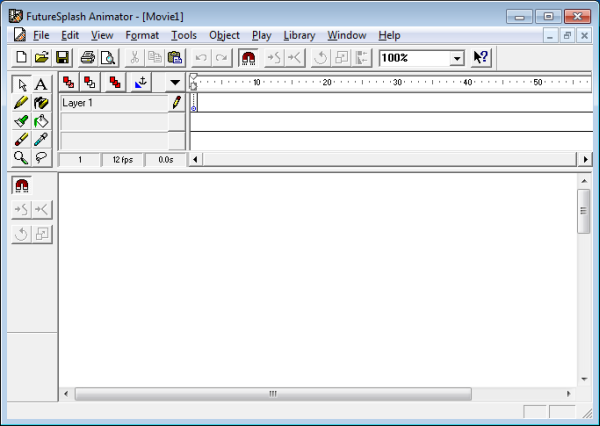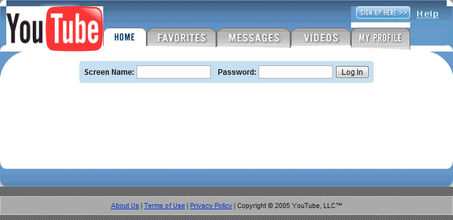Flash is a definitive part of the web’s history. And like many technologies that get caught in the web’s web, it has a rather storied history of its own. But from basically the beginning, it’s development has run parallel to the web’s.
Flash got started, conceptually, the day that Jonathan Gay met Charlie Jackson at a local Macintosh Users Group. Jackson, the group’s organizer, was looking to break into Macintosh software. As it happened, Gay had been developing software for Apple computers since high school, working on games and basic graphic editors. They connected with Michelle Welsh to help them run marketing, and, in 1993, the three founded FutureWave software.
The first target for FutureWave was pen computing (literally computers you could operate with a pen or stylus), the latest tech trend. They got to work on SmartSketch, a graphics editor for the Mac that was optimized for pen computers. The software attempted to compensate for the less natural feel of a digital stylus by combining quick and easy to use shortcuts with a forgiving and straightforward UI. In the first round of testing the product, many users noted that SmartSketch could be a useful tool for animations and rotoscoping. So right before its first official release, FutureWave added some basic animation capabilities to SmartSketch.
But there’s this thing about trends in the software world. They come and go, and it can be difficult to predict what’s going to stick around. In the two years it took FutureWave to build out SmartSketch, pen computing had more or less faded away. The World Wide Web, on the other hand, had everyone talking. But aside from text editors, there weren’t a whole lot of tools out there for web designers. FutureWave decided to pull out the animation component of SmartSketch, and rework it into a web animation tool called FutureSplash, released at the end of 1995.
FutureSplash was actually two separate, though linked, products. The software itself, FutureSplash Animator, allowed designers to lay out animations on a basic timeline, with a small layer of interactivity. At its core, it was a frame-by-frame animation tool, but even early on it introduced things like tweens and drawing tools. Like SmartSketch, the UI was clean and friendly, and allowed developers to drag and drop animations around. These animations could then be embedded on the web using the FutureSplash Viewer, a cross-platform (at the time meaning Internet Explorer and Netscape) web player that ran animations quickly and kept file-sizes small.
But users had to actually download this player in order to see animations on their browsers. So even at the very beginning, adoption by the average web user was key. The stars kind of aligned for FutureWave on that particular point.
Just a few months after the release of their FutureSplash player, Netscape added it to their list of featured extensions. In 1996, there wasn’t a whole lot of competition, so lots of users came to the Netscape site and downloaded the player out of curiosity and to keep on the cutting edge. Then, in August of 1996, Microsoft connected with FutureWave to create an embedded player for MSN.com, the default homepage on Internet Explorer. They wanted to create something akin to a television viewing experience on a certain section of their page, and after doing some research, found that FutureSplash fit the bill. So almost right away, FutureSplash got a huge amount of exposure from some of the web’s heaviest hitters.

Which is why Macromedia came calling at the end of 1996. In December of 1996, Macromedia, themselves struggling to get their own web player Shockwave to widespread adoption, bought FutureSplash. Hoping to make the name a bit more catchy, they shortened it, and released Macromedia Flash (FuturespLASH) to the world.
Over the next decade, Macromedia would help Flash evolve to relative ubiquity, adding some pretty crucial features along the way.
Take ActionScript, which was added in Flash version 5, and released in 2000. ActionScript was a literal programming language developed specifically for Flash and based off of ECMAScript. It allowed developers to hop into Flash projects and add layers of interactivity and automation to animations. And it created a whole new use case for the software.
In the very first version of FutureSplash, before it ever became Flash, there was the ability to add buttons to Flash animations. It was added rather unceremoniously and almost at the last minute, because at the end of the day, it didn’t do very much. It could skip frames around, but that was about it. Actionscript changed all that. By combining Actionscript with buttons, Flash developers could create more than just simple animations. They could create entire interactive websites.
And that’s basically what happened. Using ActionScript, buttons, and a handful of hacks, designers began to create interactive experiences using Flash as a baseline. Some used the technology to add a short intro or small widget. Others built entire sites from the ground up using only Flash, so the only HTML on the page was an embedded player.
There were drawbacks, of course. Search engines couldn’t read content that was locked inside of a Flash file so SEO went out the window, and accessibility went with it. And because everything had to be loaded upfront, Flash sites ended up quite a bit slower. But they still caught on for designers looking to do more with a website than still-super-early HTML and CSS allowed for. So Flash ushered in this whole new generation of web design.
That was quickly followed by an influx of Flash developers and animators that pushed content to the web. In fact, an entire subculture grew around the software (Newgrounds anyone? I’ll get to that story sometime soon). The web surged with games, animations, movies and entire experiences built with Flash. In many ways, Flash pushed the very boundaries of the web, and made possible what had previously been impossible.
Then, with the release of Flash version 6 (known as Flash MX) in March of 2002, Marcomedia added full video support to the software. Video was still a bit difficult to get working on the web, especially if you wanted compatibility on different browsers and operating systems. But with Flash MX, developers could embed their videos inside of a Flash animation and just like that have a cross-platform, reliable video player. And unlike some of its competitors, Flash removed a lot of cruft and chrome from its video embeds, opting instead to make things as customizable as possible.
This was in 2005, right around the time when three software engineers walked away from Paypal, deciding instead to create a startup of their own. They whiteboarded some ideas, bought a domain name and began imagining a new product for the web. After experimenting with a few half-baked dating site ideas, the three honed in on their platform’s core competency. A simple as dirt video uploading and streaming service. That’s how YouTube got started. And of course they used Flash.
In fact, Flash was a sort of serendipitous signpost for YouTube. Early on, when Chad Hurley, Steve Chen, and Jawed Karim where still struggling to find the right idea, Karim attended a BBQ where he met investor Keith Rabois. Karim happened to mention the site he was working on to Rabois, who immediately asked if their video player used Flash. Once Karim confirmed this, and demoed the site, Rabois agreed to invest on the spot. As it turns out, he was specifically looking for a company taking advantage of Flash technology, and he recognized the potential for online video. It was Rabois who convinced the YouTube team to drop their silly dating site pretenses and focus on what they were good at: uploading and streaming videos.

A year later, Google bought YouTube, and in a rising-tide way, its popularity only bolstered the ubiquity of Flash. By the time Flash celebrated its 10-year anniversary at the end of 2006, it had gotten to the point where most users didn’t even identify Flash as a separate technology from the web. Browsers bundled Flash players as part of their downloads, and designers and developers got more and more reliant on the software. Adobe even snatched the company up as part of their Macromedia acquisition.
Some of you probably know where this is going. The iPhone.
The iPhone was released in 2007. It basically redefined personal computing and, in many ways, the web. It also shipped without Flash player support. In the months before the iPhone launch, Adobe actually tried to get a lightweight version of Flash working on Apple’s new phone. At the same time, modern browsers had begun to ship with new features from HTML like native audio and video elements, replacing a lot of the functionality that Flash provided. Even the lightweight version of Flash proved not quite performant enough for the iPhone, and the decision was made to exclude it altogether.
Steve Jobs justified this move in 2010, just before the release of the iPad, in a blog post entitled Thoughts on Flash. In the post, he picked apart the issues that Apple had with Flash one by one, from performance to its closed source approach. He framed Apple’s decision as one that was meant to enhance and promote the capabilities and openness of the web.
It’s more likely that this was only one of the reasons that Flash was cut out from Apple’s mobile devices. The iPhone also came with its own ecosystem of apps and games, something that Flash typically provided on the web. So removing Flash meant removing competition. Either way though, the decision stuck. Web developers, hoping to be included in an ever growing demographic of mobile users, began to support both native HTML5 technologies and Flash, slowly fading the latter out. YouTube, despite its history with Flash, was one of the first to migrate their approach. Soon enough, modern browsers caught up and Flash, after 10 years of solid growth, experienced another decade of serious decline.
In July of 2017, Adobe announced that they would officially be ending support for the Flash software and player in 2020. This came right on the heels of announcements from just about every major browser that they would be more or less blocking Flash player in the months and years to come.
So Flash is going away. It’s story was winding and fortuitous, much like the web itself. It was far from perfect, but undoubtedly changed the way the web was used and understood. And it has a legacy that will last far longer than the software.


Leave a Reply